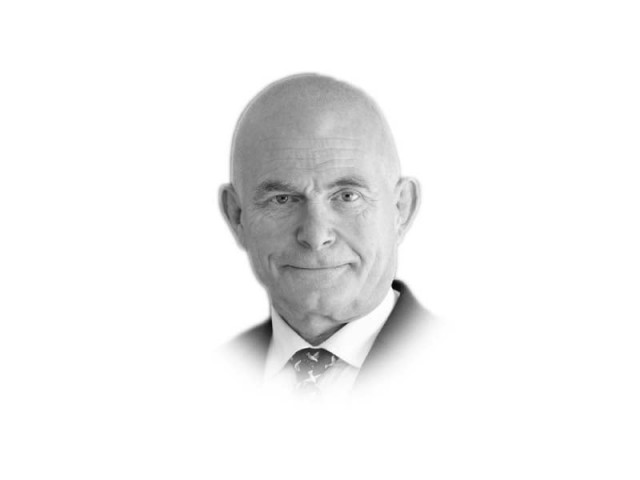Is inequality inevitable?
Overcoming inequality will lead to significant progress in human development

Inequality makes headlines every day. Most of us now, are unfortunately getting used to the bold font condemning racial injustice, gender violence, and the rising costs of living. Inequality has even defined the Covid-19 pandemic; from who gets infected to who gets vaccinated first. Within this context, one can be forgiven for thinking that inequality is simply collateral for the world we live in: ‘This is how it has always been, and this is how it will always be’. However, inequality is not inevitable.
UNDP’s Pakistan National Human Development Report (NHDR) 2020 on Inequality, entitled “The Three Ps of Inequality: Power, People, and Policy”, attempts to highlight this idea. Authored by former finance minister Dr Hafiz Pasha, the report examines inequality of income and opportunity in Pakistan, and lays out a reform agenda that can put the country on the road to an equal society.
Earlier this month, the NHDR 2020 was jointly launched by the Honourable Prime Minister Imran Khan and Ms Kanni Wignaraja, UNDP director of the Regional Bureau for Asia and the Pacific. In a special message written for the report, Mr Asad Umar, the Federal Minister for Planning, Development, and Special Reforms, speaks about the idea of two different Pakistans — one for the country’s richest, and the other for its poorest. In its exploration of inequality, the NHDR 2020 highlights how three drivers of inequality create these two different Pakistans, and lays out a blueprint for overcoming inequality in the country.
The three Ps: The key drivers of inequality: The Pakistan NHDR 2020 identifies the three Ps that drive inequality in Pakistan: Power, People, and Policy. Power, the first driver of inequality, relates to privileged groups that make use of loopholes, networks, and policies for their benefit. It is no surprise, then, that the richest 1% of Pakistan’s population holds over 9% of national income. This finding follows UNDP’s global Human Development Report (HDR) of 2020, which highlights how people who have more are able to exploit their surroundings and shift associated costs onto those who have less. The HDR therefore attempts to address ‘the gross imbalances of power and opportunity’ that prevent progress. The Pakistan NHDR’s first ‘P’ of Power highlights this theme as well.
People, the second driver of inequality, refers to the deeply embedded belief systems that encourage bias against social identities like race, class, gender, religion, or caste, among others. In Pakistan, for example, an estimated three million people live in modern slavery as bonded labourers. The NHDR 2020’s consultations with these workers highlighted that they are often faced with poor working conditions and even violence in their attempts to pay off the debts of their forefathers.
Policy, the third driver of inequality, speaks to the systems and strategies that are either ineffective, or at odds with the principles of social justice. This can be a consequence of poor implementation or even of a systemic lack of focus on the country’s most vulnerable groups. For example, Pakistan’s current government spending on human development dimensions such as education, health, and social services is estimated at only 3.5% of the GDP — lower than most South Asian countries. Increasing such spending will no doubt lead to better outcomes for the country.
The NHDR 2020 shows how the key drivers of Power, People, and Policy combine to create inequality in Pakistan, benefiting the rich at the expense of the impoverished. But what is the impact of the three Ps on the country?
The two different Pakistans — a byproduct of inequality: The NHDR 2020 shows how the key drivers of inequality lead to two different Pakistans of the haves and have-nots. For example, the richest 20% of Pakistan’s population has an HDI of 0.698, which is categorised as high human development, while the poorest 20% has an HDI of only 0.419, which corresponds to low human development. This difference is also apparent regionally. Sindh has the highest human development value in the country, followed by Punjab, Khyber-Pakhtunkhwa, and then Balochistan. However, progress in some regions is already apparent. Khyber Pakhtunkhwa, despite ranking third, has actually made the fastest improvement in human development in the country, promising substantially better outcomes for its residents.
Inequality, in this sense, is far from a statistic. It affects which schools children from impoverished backgrounds can attend, the quality of healthcare a transgender person can access, and even the jobs a person with a disability can secure. The only way to improve these lived experiences of inequality, therefore, is to focus on a singular vision of inclusion, accountability, and progress.
The one goal — overcoming inequality: Ultimately, the Pakistan NHDR 2020 points to one goal — a country that is equal both economically and in terms of services, opportunities, and acceptance towards marginalised groups. This has become especially important in the context of the on-going Covid-19 pandemic, which has left five million people in Pakistan unemployed as of June 2020, and will lead to an additional 28 million people living below the poverty line by the end of 2021.
The NHDR 2020 shows that eliminating inequality is both necessary and possible. It does so by outlining a three-point agenda targeting policies and reforms for the betterment of the country. First, Pakistan must reduce the privileges of the elite, which will involve wide-ranging tax reforms, the elimination of subsidies, and measures to ensure equitable access to land and capital. Second, the country must spend more on human development and social protection, which will lay the necessary foundation for expanding human capabilities, bridging regional disparities, and reducing inequality of opportunity. Lastly, the NHDR 2020’s reform agenda highlights the importance of improving conditions of work and providing employment. This includes enhancing the rights of workers, raising the minimum wage, and increasing non-marginal work opportunities for women.
Overcoming inequality will lead to significant progress in human development — a concept central to the success of countries like Pakistan. Pakistani economist Dr Mahbubul Haq often spoke about ‘human security’, a concept closely related to his human development approach. He said it meant “a child who did not die, a disease that did not spread, (...) a human spirit that was not crushed”. The Pakistan NHDR 2020 takes the same view, with the recognition that these inequalities are not a precondition for Pakistan. With the will to reduce privileges, prioritise human development and improve working conditions, inequality can be overcome and — with that — the overall development of Pakistan accelerated.
Published in The Express Tribune, May 4th, 2021.
Like Opinion & Editorial on Facebook, follow @ETOpEd on Twitter to receive all updates on all our daily pieces.











1733130350-0/Untitled-design-(76)1733130350-0-208x130.webp)



COMMENTS
Comments are moderated and generally will be posted if they are on-topic and not abusive.
For more information, please see our Comments FAQ